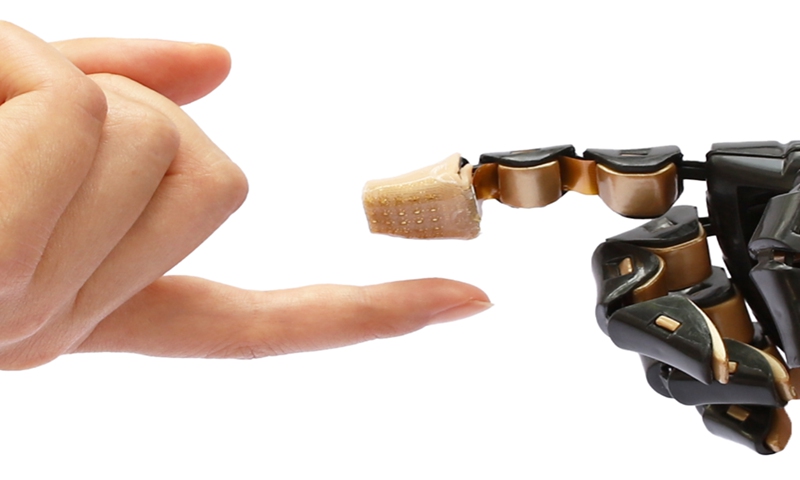Chinese scientists develop world’s first human-like electronic skin with potential applications for humanoid robots

A robotic hand equipped with a three-dimensional architected electronic skin interacts with a human hand Photo: Tsinghua University
Chinese scientists have for the first time developed a three-dimensional (3D) architected electronic skin, Xinhua News Agency reported on Wednesday, which the research team said could be applied to the skin like a band-aid to monitor real-time health data of people with potential applications in biomedical diagnosis and humanoid robots.
The electronic skin, developed by a research team led by Professor Zhang Yihui from Tsinghua University, can simultaneously decode and sense three mechanical signals, including pressure, friction and strain. The perception of the pressure position is also close to real skin.
"Electronic skin is actually a new type of sensor that mimics the sensory functions of human skin. In the future, it can be installed on the fingertips of medical robots for early diagnosis and treatment, and can also be applied like a band-aid to human skin to monitor health data such as blood oxygen and heart rate in real-time," Zhang said.
This bionic 3D electronic skin provides a new path for the development and application of electronic skin, with broad application prospects in industrial robotics, biological detection, biomedicine, and human-computer interaction.
Zhang explained that the reason why the skin is able to perceive mechanical signals is that it has a lot of tactile receptor cells that are densely arranged and have a three-dimensional spatial distribution, which can accurately perceive external stimuli. In the development of electronic skin, it is extremely challenging to recognize and decode pressure, friction and strain signals simultaneously to achieve accurate tactile sensing, as reported by Xinhua.
The team introduced that the bionic electronic skin developed consists of epidermis, dermis and subcutaneous tissue, each of which is similar in texture to the corresponding layer in human skin.
Sensors and circuits are distributed both in deep and shallow parts of the skin, with some sensors closer to the skin surface and highly sensitive to external forces, while those distributed deeper are more sensitive to skin deformation, according to Xinhua. Zhang noted that an area of electronic skin the size of the tip of the index finger contains 240 metallic sensors.
When the electronic skin touches an external object, multiple inside sensors will work together. The signals collected by the sensors are processed through a series of transmissions and extractions, and then combined with deep learning algorithms to enable the electronic skin to accurately sense the softness, hardness and shape of the object.
The resulting technology is expected to be applied to freshness assessment, biomedical diagnosis, humanoid robots, prosthetic systems and other fields, according to Tsinghua University's official website.
Photos
Related Stories
- Chinese vice premier stresses innovation in development
- Mercedes-Benz upgrades R&D center in Shanghai
- N China's Changli guides enterprises to focus on core technologies and improve innovation ability
- Chinese innovation fosters win-win cooperation at Hannover Messe
- 2024 Zhongguancun Forum to be held in late April
- China launches new original technology innovation hub construction to speed up industrial upgrades
Copyright © 2024 People's Daily Online. All Rights Reserved.









